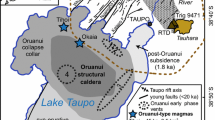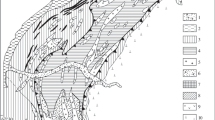Abstract
The Star Mountain rhyolite covers 500 square miles in the Davis Mountains, 100 miles east of El Paso, Texas. It appears to be the largest known rhyolitic mass to have been emplaced as a liquid flow rather than as a « froth flow » or nuée ardente. That it was emplaced as a liquid is shown by the lineation of phenocrysts, the vesicular and autobrecciated zones, baking of underlying tuffs, and by the complete absence of shard structures and evidence for welding. Three flow units with an aggregate thickness of 800 feet can be distinguished on the basis of field, chemical, and petrographic criteria. With the exception of some vesicular zones the rock is either finely crystalline and massive, or glassy and brecciated. Minor structures indicate that the flow of each unit was highly irregular.
Anorthoclase feldspar is the only significant phenocryst species in the unit. Phenocryst-groundmass compositional relationships cannot be explained on the basis of conventional granite system phase relationships, nor do recently proposed pantellerite relationships fit this case. An experimental investigation of this unusual case is under way.
A high temperature of extrusion of the rhyolite is indicated by the lack of measurable triclinicity in the feldspar. A low water vapor pressure is demonstrated by the presence of apparently primary magnetite and the scarcity of vesicular zones. Despite the low water content, high temperature caused the low viscosity necessary for the melt to spread over the 500 square mile outcrop area, presumably with approximately the same fluidity as a typical basalt flow.
Similar content being viewed by others
References
Baker, C. L. 1934,Major structural features of Trans-Pecos Texas. The Geology of Texas, vol. 2, Texas Univ. Bull., 3401, 137–214.
Boyd, F. R., 1961,Welded tuffs and flows in the Rhyolite Plateau of Yellowstone Park, Wyoming. Bull. Geol. Soc. Am.,72, 387–426.
Buddington, A. F., &Lindsley, D. H., 1964,Iron titanium oxide minerals and synthetic equivalents, Jour. Petrol.,5, No. 2, 310–357.
Carmichael, I. S. E., &Mackenzie, W. S., 1963,Feldspar-liquid equilibria in pantellerites: an experimental study. Am. Jour. Sci.,261, 382–396.
Cross, W., 1904,Analyses of West Texas rocks, Bull. Geol. Soc. Amer., 228.
Deer, W. A., Howie, R. A., Zussman, J., 1963,Rock-Forming Minerals: vol. 2,Chain Silicates, New York: Wiley, 379 pp.
Dunnay, G., & Donnay, J. D. H., 1952,The symmetry change in the high-temperature alkali-feldspar series. Am. Jour. Sci., Bowen Vol., part 1, 115–132.
Dwyer, R. J., &Oldenberg, O., 1944,The dissociation of H2O into H + OH. Jour. Chem. Phys.,12, 351–361.
Eifler, G. K., Jr., 1951,Geology of the Barrilla Mountains, Texas, Bull. Geol. Soc. Amer.,62, 339–353.
Friedman, I., Long, W., &Saith, R. L., 1963,Viscosity and water content of rhyolite glass. Jour. Geophys. Res.,68, 6523–6535.
Gibbon, D. L., &Wyllie, P. T., 1969,Experimental studies of igneous rock series: The Farrington Complex, North Carolina, and the Star Mountain rhyolite, Texas. Jour. Geol. 77, 221–239.
Goldsmith, J. R., &Laves, F., 1954,Microcline-sanidine stability relations. Geochim et Cosmoch. Acta,5, 1–9.
Kennedy, G. C., 1948,Equilibrium between volatiles and iron oxides in igneous rocks. Am. Jour. Sci., 5th ser.,246, 529–549.
Kozu, S., &Kani, K., 1935,Viscosity measurements of the ternary system Di-Ab-An at high temperature. Proceed. Imper. Acad. (Tokyo),11, pp. 383.
Laves, F., 1950,The lattice and twinning of microcline and other potash feldspars. Jour. Geol.,58, 548–571.
Lonsdale, J. T., 1940,Igneous rocks of the Terlingua-Solitario region, Texas. Bull. Geol. Soc. Amer.,51, 1539–1626.
McAnulty, W. N., 1955,Geology of Cathedral Mountain quadrangle, Brewster County, Texas. Bull. Geol. Soc. Amer.,66, 531–578.
Nichols, R. L., 1939,Viscosity of lava. Jour. Geol.,47, 290–302.
Orville, P. M., 1958,Feldspar investigations. Carnegic Inst Wash. Yearb.,57, 206–209.
Phair, G., & Fisher, F. G., 1962,Laramide comagmatic series in the Colorado Front Range: the feldspars. InPetrologic Studies: A Volume to Honor A. F. Buddington.
Piwinski, A. J., 1965,Experimental study of rocks from a zoned pluton. Unpublished M. S. thesis, Penn State University.
Ross, C. S., 1962,Microlites in glassy volcanic rocks. Amer. Min.,47, 723–740.
Shapiro, L., &Brannock, W. W., 1962,Rapid analysis of silicate, carbonate and phosphate rocks. U. S. Geol. Surv. Bull., 1144-A, 1–56.
Shaw, H. R., 1963,Obsidian-H2O viscosities at 1000 and 2000 bars in the temperature range 700° to 900° C. Jour. Geophys. Res.,68, No. 23, 6337–6343.
Smith, R. L., 1960,Ash flows. Bull. Geol. Soc. Amer.,71, 795–841.
Tröger, W. E., 1959,Optische Bestimmung der Gesteinsbildenden Minerale. Teil 1. Stuttgart: E. Schweizerbart’sche Verlagsbuchhandlung, 147 pp.
Turner, F. J., &Verhoogen, J., 1960,Igneous and Metamorphic Petrology. New York: McGraw-Hill, 694 pp.
Tuttle, O. F., 1952,Origin of the contrasting mineralogy of extrusive and plutonic salic rocks. Jour. Geol.,60, 107–124.
-----, &Bowen, N. L., 1958,Origin of granite in the light of experimental studies in the system NaAlSi s O s -KAlSi 1 O s -SiO 2-H 2 O. Geol. Soc. Amer. Mem.,74, 153 pp.
Winkler, H. G. F., 1960,La génèse du granite et des migmatites par anatéxie expérimentale. Revue de Géographie physique et de Géologie Dynamique, vol. III, fasc. 2, 67–76.
—————, &Von Platen, H., 1961,Experimentelle gesteinmetamorphose: V. Experimentelle anatektische schmelzen und ihre petrogenetische bedeutung. Geochim. et. Cosmoch. Acta,24, 250–259.
—————, 1963,Effects of the changes in slope occurring on liquidus and solidus paths in the system diopside-anorthite-albite. Min. Soc. Amer. Special Paper,1, 204–212.
Author information
Authors and Affiliations
Rights and permissions
About this article
Cite this article
Gibbon, D.L. Origin and development of the Star Mountain rhyolite. Bull Volcanol 33, 438–474 (1969). https://doi.org/10.1007/BF02596519
Received:
Issue Date:
DOI: https://doi.org/10.1007/BF02596519




